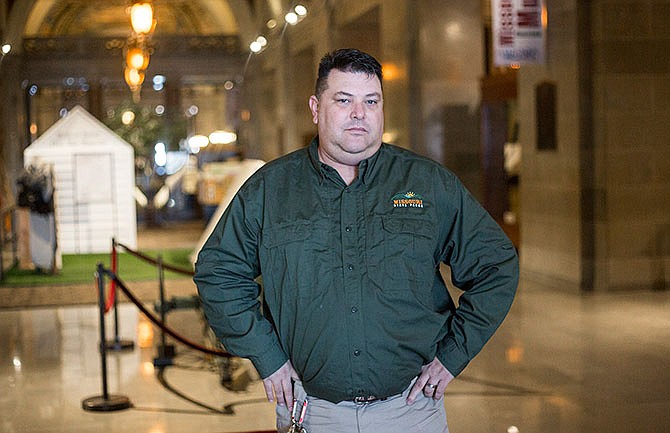Chris Fritsche brought with him military background, park interpretation experience, an interest in Native American contributions and a gung-ho attitude when he returned to Missouri seven years ago.
He returned to his native state from California after his position was lost in the economic collapse. But, as his family was driving halfway across the country without jobs or housing when they arrived, the Department of Natural Resources had sent a letter requesting his application.
He joined the Missouri State Museum staff as an interpretive resource specialist 1, conducting tours of the Capitol. He then worked his way up to specialist 2, in charge of the part-time staff. Now, he is specialist 3, in charge of all the interpretive staff.
"I love doing it," Fritsche said.
Since taking over, he has put a greater emphasis on programming. Both part-time and full-time staff members take turns researching a Missouri history topic to share with the public.
Fritsche has built a dinosaur and transformed a museum wing into a cave. Next, he hopes to introduce visitors to the mines of Missouri and the early people who came here for the industry.
Under Fritsche's watch, the museum also has upped its events, adding "Tuesdays at 2" for children during the summer and the "After Hours" program monthly for adults. They hosted a first-time picnic at the Jefferson Landing State Historic Site, which he hopes to make a recurring event, too.
"We want to get the community more involved," he said.
In the future, he would like to see a teen program developed.
"We want to build a love of the museum and state parks, a love of nature and of history," Fritsche said. "I'm pretty proud of what we've accomplished."
Being inside the iconic Capitol building, the museum is a magnet for nearly 50,000 school children each spring in addition to the traditional visitors throughout the year. March through May, a staff member embarks every 20 minutes on a 60-minute tour 19 times a day.
"Everything goes on hold in those months," Fritsche said.
But Fritsche wants to make sure the local people do not forget the museum.
"Use us, that's why we're here," he said.
Fritsche served nine years in the U.S. Marine Corps, including a tour during the Gulf War.
He has been married to Deanna for 24 years, with children Samantha, 21, and C.J, 19.
Fritsche was a tribal ranger on the 17,000 acres of the Agua Caliente Band of Cahuilla Indian land. For eight years, he led tours and collected significant tribal history within the palm oasis in the midst of a desert.
"It was neat to dive down into their history and talk to the elders," he said.
During his time on the tribal land, Fritsche also assisted with an Oscar-winning documentary.
What he learned is that culture evolves. What a tribe does today and what the same group did 1,000 years ago likely wouldn't be recognizable to the other, he said.
A member of the Osage tribe, Fritsche said he has gained a greater appreciation for his heritage, with time.
"It's now more a part of me."
At the museum, he has presented on the Osage and other once-thriving groups native to Missouri.
"People say kids don't like history," Fritsche said. "I think you can't appreciate it until you have your own history."

